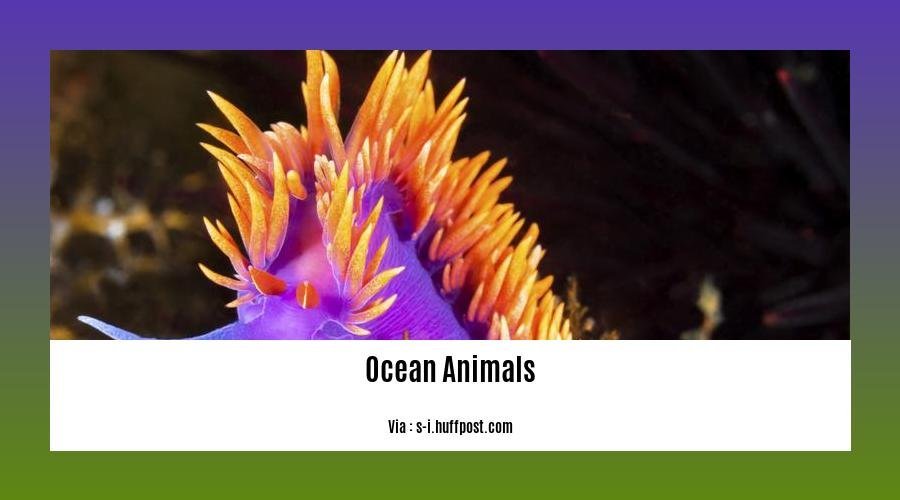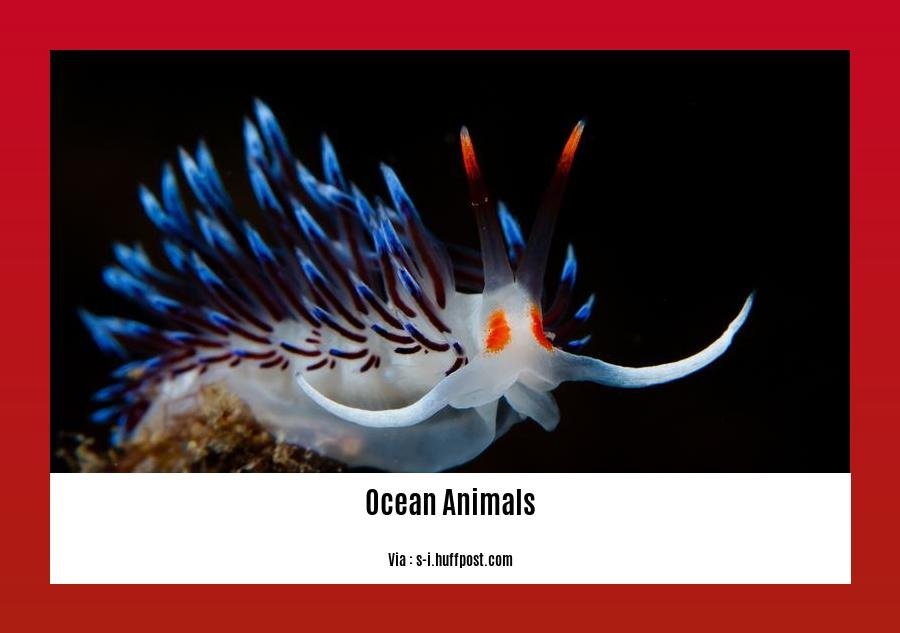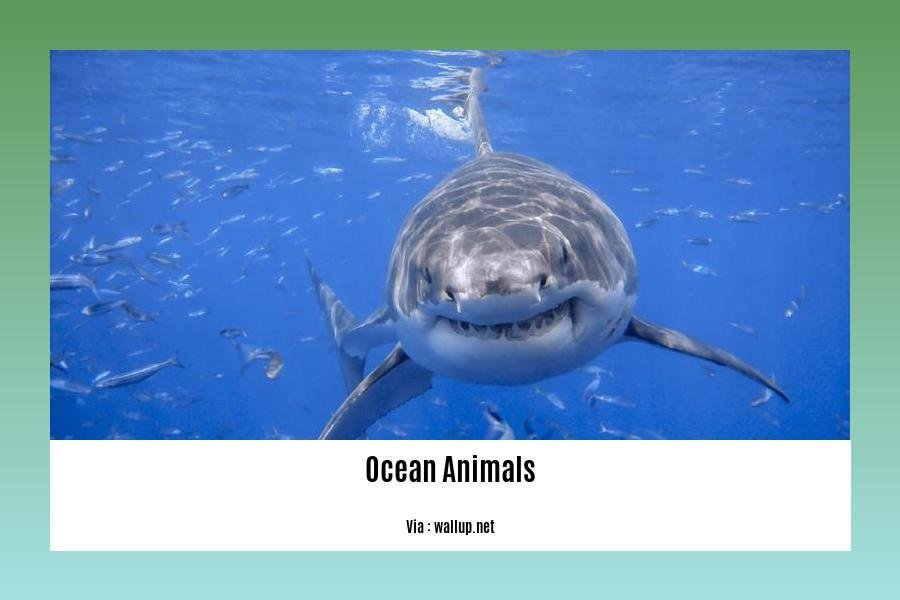Welcome to the captivating world of ocean animals, where mystery and awe collide with incredible facts and remarkable species. In this article, “Unveiling the Wonders: Fascinating Facts About Ocean Animals,” we dive into the depths of our vast oceans, uncovering hidden gems of knowledge about the magnificent creatures that call it home. From the enchanting intelligence of dolphins to the mesmerizing adaptations of deep-sea organisms, prepare to be amazed by the wonders that await beneath the surface.
Key Takeaways:
- The blue whale holds the title of being the largest sea mammal and the largest known animal on Earth.
- Sea turtles have been around since the time of dinosaurs, making them one of the oldest surviving species.
- While most sharks are cold-blooded, certain species, such as the great white shark, are warm-blooded.
- Sea lions, seals, and walruses are known as pinnipeds and have flippers resembling wings.
- Dolphins possess exceptional hearing and vision.
- Whales communicate with each other through singing.
- Male seahorses are unique as they give birth to their offspring and provide care for their young.
- Shrimps have their hearts in their heads, which is an intriguing anatomical feature.
- Sea sponges, despite lacking various body parts like a head, eyes, or a brain, are living organisms.
- Turtles can be found on every continent except Antarctica, proving their widespread presence.
- The vast marine ecosystems are home to approximately 230,000 identified marine species.
Facts About Ocean Animals

Blue Whales: Giants of the Sea
- Did you know that the blue whale is not only the largest sea mammal but also the largest known animal in the entire world? These magnificent creatures can reach lengths of up to 100 feet and weigh as much as 200 tons! Standing next to a blue whale would be like standing beside a colossal skyscraper!
- As astounding as their size is, it’s equally fascinating to learn that blue whales exclusively feed on tiny shrimp-like organisms called krill. In fact, they consume about 4 tons of krill every day to sustain their enormous bodies. Talk about a voracious appetite!
Timeless Sea Turtles
- Sea turtles are truly survivors from prehistoric times, having existed since the era of dinosaurs, which dates back millions of years. These resilient creatures have adapted to various ocean habitats over time, making them one of the longest-living species on Earth.
- One intriguing fact about sea turtles is their unique ability to travel long distances across the ocean. They possess an incredible navigational skill known as “beach imprinting”; hatchlings remember the exact beach they hatched on and can return to it many years later to lay their own eggs.
Sharks: Cold-Blooded Predators
- When you think of sharks, you might imagine them lurking in the depths of the ocean, but did you know that most sharks are actually cold-blooded? This means that their body temperature matches the temperature of the water they inhabit.
- However, there are exceptions to this rule. The great white shark is an example of a warm-blooded shark. With the help of their large livers and unique circulatory system, great white sharks can regulate their body temperature slightly above that of the surrounding water. This allows them to thrive in colder ocean regions.
Meet the Pinnipeds: Sea Lions, Seals, and Walruses
- Have you ever noticed that sea lions, seals, and walruses seem to have “winged feet”? These marine mammals, collectively known as pinnipeds, have evolved distinct flippers that resemble wings, enabling them to navigate through the water with remarkable agility.
- Pinnipeds are well-adapted to both land and water. While they use their flippers to swim gracefully in the ocean, they can also haul themselves out onto rocky shores or ice sheets, using their strong front flippers to propel themselves forward on land.
Dolphins: Marvels of Sensory Perception
- Dolphins are known for their playful nature and incredible intelligence, but they also possess exceptional sensory abilities. One of their key senses is hearing, which is important for navigation and communication in their underwater realm.
- While dolphins can hear frequencies far beyond our human range, they are also capable of producing clicks and whistles, creating intricate vocalizations. It’s believed that these sounds allow dolphins to “see” underwater by creating a sonic image based on the echoes they receive, similar to how bats navigate in the dark.
Whales: Songs of the Deep
- Whales are renowned for their enchanting songs that resonate through the ocean. These unique vocalizations serve as a form of communication within their social groups and can travel for miles, reaching other whales across vast distances.
- It’s fascinating to think that each whale’s song is distinctive, much like a human fingerprint. Individual whales have their own unique melodies, which they use to establish their identity and presence in the vast expanses of the ocean.
Seahorses: Fathers of the Sea
- In the underwater world, things can sometimes take an unexpected turn. One such example is in the case of seahorses, where it’s the male who carries the responsibility of pregnancy and childcare.
- Male seahorses have a unique pouch on their abdomen, specifically designed for incubating and nurturing the eggs laid by the female. Once the eggs are safely deposited in the male’s pouch, he takes on the role of caring for and protecting the developing embryos, providing a safe haven until they are ready to emerge into the world as fully formed seahorses.
Shrimps: Hearts in Their Heads
- Shrimps, those tiny crustaceans that scuttle across the ocean floor, hide a fascinating secret. Their hearts are not located in their chests like ours; instead, they reside within their heads!
- This peculiar anatomical feature allows shrimps to pump blood more efficiently throughout their bodies, ensuring that essential oxygen and nutrients reach all their vital organs. Talk about having a head and heart in the right place!
Enigmatic Sea Sponges
- Sea sponges are truly remarkable organisms. Despite their lack of identifiable body parts like heads, mouths, or even brains, they are living organisms crucial to marine ecosystems.
- These captivating creatures filter water to obtain the microscopic food particles they need to survive. They play a vital role in maintaining the health of coral reefs and provide shelter for countless other marine species, showcasing the interconnectedness of life beneath the ocean’s surface.
Turtles: Global Guardians
- Turtles can be found in various corners of the world, except for Antarctica, where the icy conditions are too inhospitable for their survival. From tropical coastlines to temperate oceans, these ancient reptiles have adapted to diverse environments, proving their resilience time and time again.
- Sea turtles are not only fascinating creatures, but they also play a crucial role as guardians of the ocean. By maintaining seagrass beds and controlling jellyfish populations, they contribute to the overall health and balance of marine ecosystems.
The Vast Diversity of Marine Life
- Dive beneath the waves, and you’ll discover a vast ocean teeming with life. It’s estimated that there are approximately 230,000 known marine species, each with its own unique characteristics and adaptations, creating a rich tapestry of biodiversity beneath the surface.
- From the microscopic organisms that form the base of the marine food chain to the majestic giants that awe us with their size and strength, the variety of ocean animals never ceases to amaze, reminding us of the endless wonders that lie hidden within the depths.
In Conclusion
- The world of ocean animals is nothing short of extraordinary. From the impressive size of blue whales to the timeless existence of sea turtles, the captivating communication of whales to the unexpected parenting roles of seahorses, each fact unraveled exposes a glimpse into the marvels of this watery realm.
- By understanding and appreciating these facts about ocean animals, we can foster a deeper connection with the marine world and its inhabitants. Let us cherish and protect these remarkable creatures, ensuring that they continue to inspire and captivate us for generations to come.
Please note that additional facts and information about ocean animals can be found in the sources listed below:
- Facts & Information About Sea Animals for Kids – Firstcry.com
- Ocean Animals Facts: 10 Amazing Things About Marine Life – All That’s Interesting
If you’re looking for fascinating facts about house cats, make sure to check out our page on facts about house cats. You won’t believe what you’ll discover about these furry companions!
Interested in marine animals? Dive into the world beneath the waves by exploring our page on facts about marine animals. Prepare to be amazed by the incredible creatures that inhabit our oceans.
Discover the wonders of marine life by visiting our page on facts about marine life. From the smallest plankton to the largest whales, you’ll be captivated by the diversity and beauty of the underwater world.
Fascinating Behaviors of Ocean Animals

The Earth’s oceans are teeming with an astounding diversity of life, and the behaviors of ocean animals never cease to captivate and amaze us. From the peculiar habits of sea cucumbers to the surprising presence of reptiles and birds in the ocean, there is a world of wonder waiting to be discovered beneath the waves. In this article, we will delve into some of the most intriguing behaviors exhibited by ocean animals.
Sea Cucumbers: Nature’s Vacuum Cleaners
Sea cucumbers may not be the first marine creatures that come to mind when thinking about fascinating ocean behaviors, but these peculiar animals play a vital role in maintaining the health of the ocean floor. They are affectionately referred to as “Nature’s Vacuum Cleaners” due to their remarkable eating habits. Sea cucumbers feed on detritus and decaying matter, effectively cleaning up organic waste and recycling it into nutrients for other marine organisms. Their unique ability to contribute to the ecosystem’s balance makes them worthy of our attention and respect. (lolaapp.com, source)
Mollusks: Masters of the Ocean
Mollusks comprise a diverse group of invertebrates, and their fascinating behaviors make them an integral part of the ocean’s tapestry of life. From the beautiful shells created by bivalves to the incredible camouflage abilities of cephalopods, these creatures never fail to astound us. Did you know that octopuses possess the remarkable ability to change their appearance and mimic the color and texture of their surroundings? This camouflage adaptation allows them to blend seamlessly into their environment and avoid predators or ambush prey. Discovering the world of mollusks reveals the incredible diversity and adaptive capabilities of ocean animals. (Surf Researcher, source)
Reptiles and Birds: Surprising Inhabitants of the Ocean
While we typically associate reptiles and birds with terrestrial environments, it may come as a surprise that they can be found in the open ocean as well. Sea turtles gracefully navigate the vast expanse of the ocean, often covering thousands of miles during their migrations. This incredible feat reveals their remarkable adaptation to a life at sea. Similarly, seabirds take to the skies above the ocean, effortlessly soaring over vast distances and relying on this environment for their survival. These unexpected ocean-dwelling creatures remind us of the interconnectedness of different ecosystems and the boundless wonders of nature. (Surf Researcher, source)
The Enigmatic World of Deep Ocean Animals
The deep ocean holds a mysterious allure that has fascinated researchers for generations. The extreme depths and harsh conditions have shaped the behavior and adaptations of the seemingly alien creatures that call this realm home. From bioluminescent organisms that produce mesmerizing light displays to deep-sea fish with highly specialized sensory organs, these animals have evolved unique strategies to survive in an environment devoid of sunlight. Exploring the secrets of the deep ocean not only expands our knowledge but also invites us to appreciate and protect these fragile and extraordinary ecosystems. (Surf Researcher, source)
Corals: Dazzling Collaborators
Coral reefs are among the most diverse and vibrant ecosystems on Earth, and behind their colorful facade lies a fascinating partnership. Corals are not individual organisms but colonies made up of numerous coral polyps. These polyps rely on a mutually beneficial relationship with symbiotic algae called zooxanthellae. The algae provide the corals with essential nutrients through photosynthesis, while the corals provide protection and a suitable environment for the algae to thrive. This delicate harmony between corals and zooxanthellae underscores the intricate relationships that exist in the ocean and emphasizes the importance of conserving these precious habitats. (Outforia, source)
Key Takeaways:
Sea cucumbers serve as “Nature’s Vacuum Cleaners,” eating detritus and helping to clean the ocean floor.
Mollusks, such as octopuses, showcase remarkable adaptive capabilities, including camouflage and mimicry.
Reptiles like sea turtles and birds like seabirds defy expectations by inhabiting and thriving in the open ocean.
The deep ocean is home to a multitude of bizarre and bioluminescent creatures with unique adaptations.
Corals rely on a symbiotic relationship with zooxanthellae algae, highlighting the intricate collaboration in marine ecosystems.
Citation:
– Lolaapp.com: source
– Surf Researcher: source
– Outforia: source
Threats to Ocean Animal Populations
The world’s oceans and the animals that call them home are facing a multitude of threats that endanger their survival and biodiversity. These threats, including global warming, overfishing, habitat loss and degradation, pollution, and climate change, have far-reaching implications for the delicate ecosystems of the ocean.
Global warming is one of the most significant threats to ocean animal populations. As a result of human activities, the rise in temperature is causing alterations in ocean chemistry and disrupting essential processes. This poses a particular danger to species that cannot adapt to higher temperatures.
Overfishing is another major concern that has led to the depletion of fish populations in many parts of the world. This not only endangers the targeted species but also disrupts the delicate balance of marine ecosystems as a whole.
Habitat loss and degradation further exacerbate the decline of marine animals. Activities such as coastal development, destructive fishing practices, and the destruction of coral reefs have resulted in the loss of crucial habitats for numerous species.
Pollution, including plastic pollution, chemical pollution, and oil spills, poses a significant threat to the well-being of marine animals. These pollutants harm marine life through ingestion or entanglement and disrupt marine ecosystems and food chains.
Climate change, driven by greenhouse gas emissions, has wide-ranging impacts on the oceans and marine animals. Rising sea temperatures, ocean acidification, and changing ocean currents all have detrimental effects on marine life and its ability to survive and thrive.
Conservationists emphasize the urgent need to protect marine animals and advocate for the creation of expansive marine reserves. These reserves provide protected areas where marine species can thrive and offer opportunities for scientific research and monitoring.
It is estimated that over 1,550 marine animals and plants are at risk of extinction, with climate change impacting at least 41% of threatened marine species. Efforts to conserve and protect endangered marine species through conservation measures, legislation, and international cooperation are crucial to prevent further decline.
In conclusion, the threats facing the ocean and its animal populations are varied and substantial. Urgent action is needed to protect and conserve these vulnerable ecosystems and the species that depend on them.
Key Takeaways:
– Global warming, overfishing, habitat loss and degradation, pollution, and climate change are the major threats to ocean animal populations.
– Rising temperatures and alterations in ocean chemistry due to global warming pose a significant danger to species that cannot adapt.
– Overfishing disrupts marine ecosystems and depletes fish populations.
– Habitat loss and degradation, caused by activities like coastal development and destructive fishing practices, lead to the loss of crucial habitats for marine animals.
– Pollution, including plastic pollution, chemical pollution, and oil spills, directly harms marine life and disrupts marine ecosystems and food chains.
– Climate change affects marine life through rising sea temperatures, ocean acidification, and changing ocean currents.
– Conservation efforts, including the creation of marine reserves, are necessary to protect endangered marine species and their habitats.
Sources:
– Oceans and the Threats They Face | National Geographic.
– 11 of the Most Endangered Species in the Ocean | Earth.Org.
Conservation Efforts for Ocean Animals
The world’s oceans are home to a diverse array of fascinating and magnificent creatures. From graceful sea turtles to majestic whales, these ocean animals captivate our imaginations and play vital roles in maintaining the health of marine ecosystems. However, many of these species are facing numerous threats and are in need of our conservation efforts to ensure their survival. In this article, we will explore the importance of conservation efforts for ocean animals and the steps being taken to protect their habitats.
The Importance of Ocean Conservation
Conserving the oceans and the animals that inhabit them is crucial for several reasons. By protecting marine wildlife and their habitats, we can:
Maintain Resilient Oceans: Ocean conservation efforts seek to create more resilient oceans by safeguarding the habitats of marine animals. This is essential for preserving the delicate balance of marine ecosystems and ensuring the survival of various species. (World Wildlife Fund)
Support Livelihoods: Over 250 million people depend on ocean ecosystems for their livelihoods. It is vital to protect and conserve these habitats to ensure the sustainability of industries such as fishing and tourism, which are essential for coastal communities. Sustainable fishing practices, reducing pollution, and preventing habitat destruction are all key components of ocean conservation. (World Wildlife Fund)
Mitigate Threats: Marine animals face various threats, including pollution, overfishing, habitat destruction, and climate change. These factors contribute to the decline in populations of endangered species and disrupt the delicate balance of marine ecosystems. Conservation efforts aim to mitigate these threats through initiatives and rescue operations. (The Marine Mammal Center)
Protect Endangered Species: Several marine species, including sea turtles, sharks, and marine mammals, are endangered. Conservation efforts and legislation play a vital role in protecting these species and ensuring their survival. (American Oceans)
Preserve Economic Benefits: Healthy oceans contribute to economic growth and sustenance for coastal communities. People rely on the ocean for food, tourism, and various industries. Conserving marine ecosystems ensures the long-term viability of these economic benefits. (World Wildlife Fund)
Conservation Initiatives and Actions
To address the threats facing ocean animals and their habitats, numerous conservation organizations are actively working towards their protection. Some of the key initiatives include:
Establishing Marine Reserves: Creating expansive marine reserves helps safeguard the biodiversity of the oceans. These protected areas provide refuge for marine species to thrive and also serve as a platform for scientific research and monitoring. (National Geographic)
Advocating for Sustainable Practices: Conservation organizations advocate for sustainable fishing practices to prevent overfishing and support the recovery of fish populations. This includes implementing fishing quotas, promoting selective fishing methods, and reducing bycatch.
Reducing Pollution: Efforts to reduce pollution, particularly plastic pollution, are crucial for the well-being of marine animals. Conservation organizations raise awareness about the impact of pollution on marine life and advocate for changes in waste management practices and the reduction of single-use plastics.
Restoring and Protecting Habitats: Conservation efforts focus on restoring and protecting crucial habitats such as coral reefs, mangroves, and seagrass meadows. These habitats provide shelter, food, and breeding grounds for countless species and play a vital role in maintaining biodiversity.
Educating and Raising Awareness: Conservation organizations play a crucial role in educating the public about the importance of ocean conservation. By raising awareness about the threats facing marine animals and the actions individuals can take, they inspire people to make positive changes in their daily lives.
Key Takeaways:
- Ocean conservation efforts are essential for maintaining resilient oceans and protecting marine wildlife and their habitats.
- Over 250 million people rely on ocean ecosystems for their livelihoods.
- Pollution, overfishing, habitat destruction, and climate change are major threats to marine animals.
- Conservation initiatives focus on creating marine reserves, advocating for sustainable practices, reducing pollution, restoring habitats, and raising awareness.
- Protecting endangered species and preserving economic benefits are key goals of ocean conservation.
Citation:
– World Wildlife Fund
– The Marine Mammal Center
FAQ
Q1: What is the largest sea mammal in the world?
A1: The blue whale holds the title for being the largest sea mammal and the largest known animal in the world.
Q2: How long have sea turtles been around?
A2: Sea turtles have been existing since the time of dinosaurs, making them one of the oldest creatures on Earth.
Q3: Are all sharks cold-blooded?
A3: Most sharks are cold-blooded, but some species, like the great white shark, are warm-blooded.
Q4: What are pinnipeds?
A4: Sea lions, seals, and walruses are called pinnipeds. They possess flippers resembling wings on their feet.
Q5: How do whales communicate?
A5: Whales communicate through singing, producing complex sounds and songs that can travel long distances underwater.
















